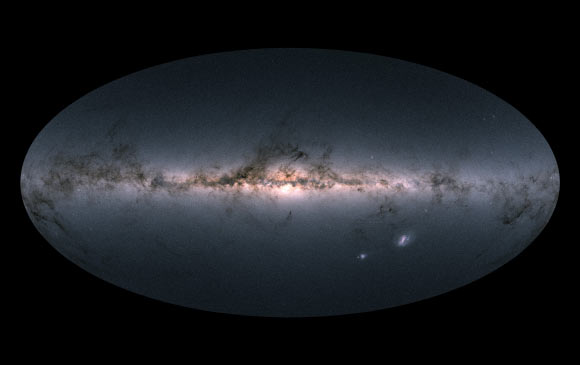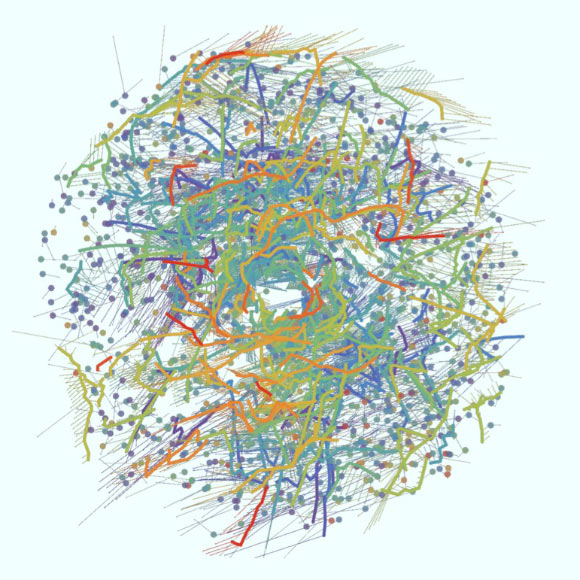ESA’s Gaia Space Telescope Traces Milky Way’s Stellar Families | Astronomy – Sci-News.com
Astronomers using data from ESA’s Gaia spacecraft have identified a number of clusters, associations and co-moving groups of stars within about 3,300 light-years. Many of these stellar groups appear to be filamentary or string-like, oriented in parallel to the Milky Way’s plane, and some span hundreds of light-years in length.

Gaia’s all-sky view of our Milky Way Galaxy and neighboring galaxies, based on measurements of nearly 1.7 billion stars. Brighter regions indicate denser concentrations of especially bright stars, while darker regions correspond to patches of the sky where fewer bright stars are observed. The color representation is obtained by combining the total amount of light with the amount of blue and red light recorded by Gaia in each patch of the sky. The bright horizontal structure that dominates the image is the Galactic plane, the flattened disc that hosts most of the stars in our home Galaxy. In the middle of the image, the Galactic center appears vivid and teeming with stars. Darker regions across the Galactic plane correspond to foreground clouds of interstellar gas and dust, which absorb the light of stars located further away, behind the clouds. Many of these conceal stellar nurseries where new generations of stars are being born. Sprinkled across the image are also many globular and open clusters — groupings of stars held together by their mutual gravity, as well as entire galaxies beyond our own. The two bright objects in the lower right of the image are the Large and Small Magellanic Clouds, two dwarf galaxies orbiting the Milky Way. In small areas of the image where no color information was available — to the lower left of the Galactic center, to the upper left of the Small Magellanic Cloud, and in the top portion of the map — an equivalent grayscale value was assigned. Image credit: ESA / Gaia / DPAC.
Exploring the distribution and past history of the starry residents of our Milky Way Galaxy is especially challenging as it requires astronomers to determine the ages of stars. This is not at all trivial, as ‘average’ stars of a similar mass but different ages look very much alike.
To figure out when a star formed, scientists must instead look at populations of stars thought to have formed at the same time — but knowing which stars are siblings poses a further challenge, since stars do not necessarily hang out long in the stellar cradles where they formed.
“To identify which stars formed together, we look for stars moving similarly, as all of the stars that formed within the same cloud or cluster would move in a similar way,” said Dr. Marina Kounkel, a postdoctoral researcher in the Physics and Astronomy Department at the Western Washington University.
“We knew of a few such co-moving star groups near the Solar System, but Gaia enabled us to explore the Milky Way in great detail out to far greater distances, revealing many more of these groups.”

This diagram shows a face-on view of stellar ‘families’ — clusters (dots) and co-moving groups (thick lines) of stars — within about 3,300 light-years from the Sun, which is located at the center of the image. Each family is identified with a different color and comprises a population of stars that formed at the same time. Purple hues represent the oldest stellar populations, which formed around 1 billion years ago; blue and green hues represent intermediate ages, with stars that formed hundreds of millions of years ago; orange and red hues show the youngest stellar populations, which formed less than a hundred million years ago/ Thin lines show the predicted velocities of each group of stars over the next 5 million years, based on Gaia’s measurements. The lack of structures at the center is an artifact of the method used to trace individual populations, not due to a physical bubble. Image credit: M. Kounkel & K. Covey.
Dr. Kounkel and Dr. Kevin Covey, also from the Physics and Astronomy Department at the Western Washington University, used data from Gaia’s second release to trace the structure and star formation activity of a large patch of space surrounding the Solar System, and to explore how this changed over time.
The analysis uncovered nearly 2,000 previously unidentified clusters and co-moving groups of stars up to about 3,300 light years from us.
The authors also determined the ages for hundreds of thousands of stars, making it possible to track stellar ‘families’ and uncover their surprising arrangements.
“Around half of these stars are found in long, string-like configurations that mirror features present within their giant birth clouds,” Dr. Kounkel said.
“We generally thought young stars would leave their birth sites just a few million years after they form, completely losing ties with their original family, but it seems that stars can stay close to their siblings for as long as a few billion years.”
The stellar strings also appear to be oriented in particular ways with respect to the Milky Way’s spiral arms — something that depends upon the ages of the stars within a string. This is especially evident for the youngest strings, comprising stars younger than 100 million years, which tend to be oriented at right angles to the spiral arm nearest to our Solar System.
The astronomers suspect that the older strings of stars must have been perpendicular to the spiral arms that existed when these stars formed, which have now been reshuffled over the past billion years.
“The proximity and orientation of the youngest strings to the Milky Way’s present-day spiral arms show that older strings are an important ‘fossil record’ of our Galaxy’s spiral structure,” Dr. Covey said.
“The nature of spiral arms is still debated, with the verdict on them being stable or dynamic structures not settled yet. Studying these older strings will help us understand if the arms are mostly static, or if they move or dissipate and re-form over the course of a few hundred million years — roughly the time it takes for the Sun to orbit around the galactic center a couple of times.”
The research was described in a paper in the Astronomical Journal (arXiv.org preprint).
_____
Marina Kounkel & Kevin Covey. 2019. Untangling the Galaxy. I. Local Structure and Star Formation History of the Milky Way. AJ 158, 122; doi: 10.3847/1538-3881/ab339a





